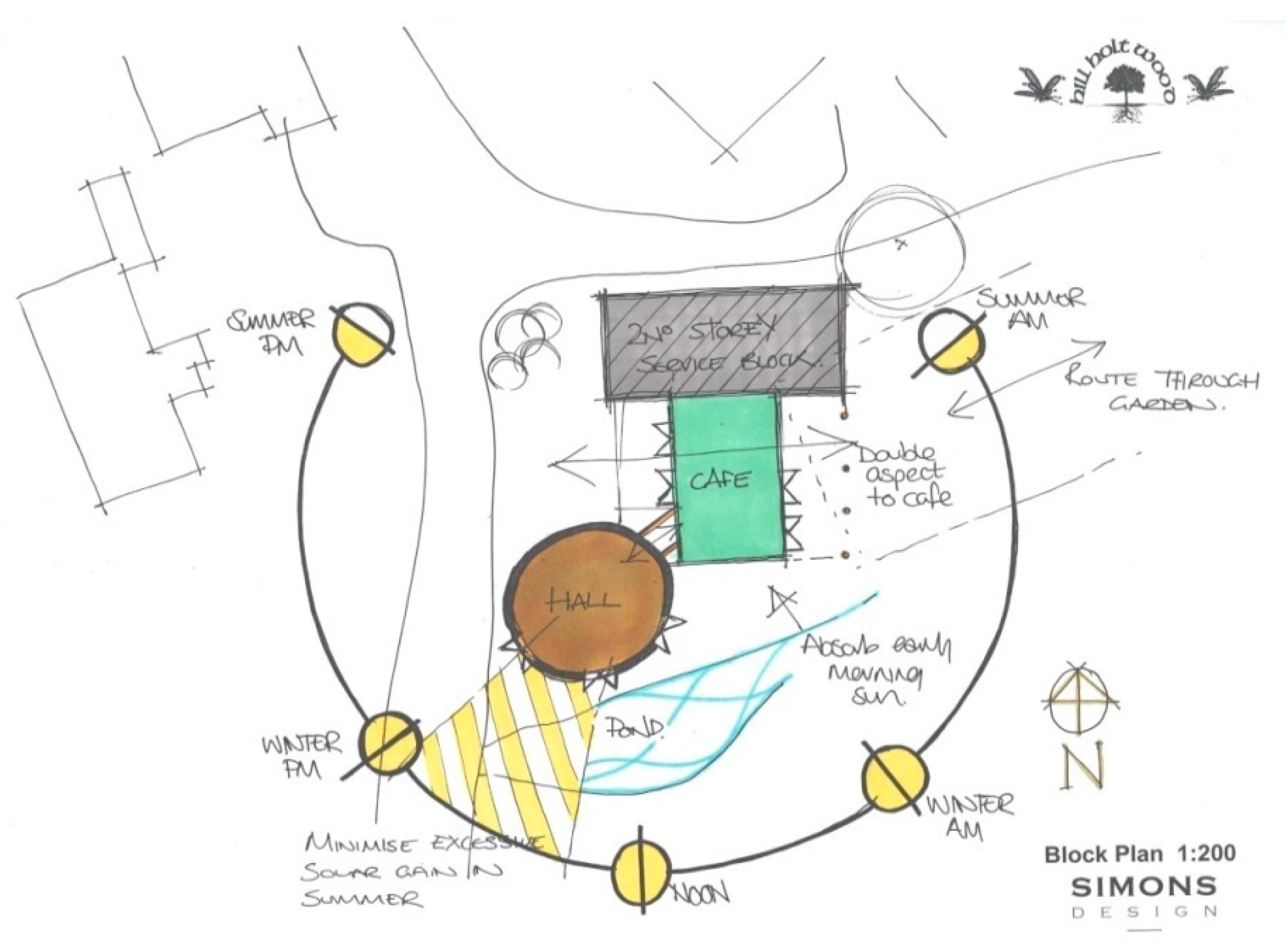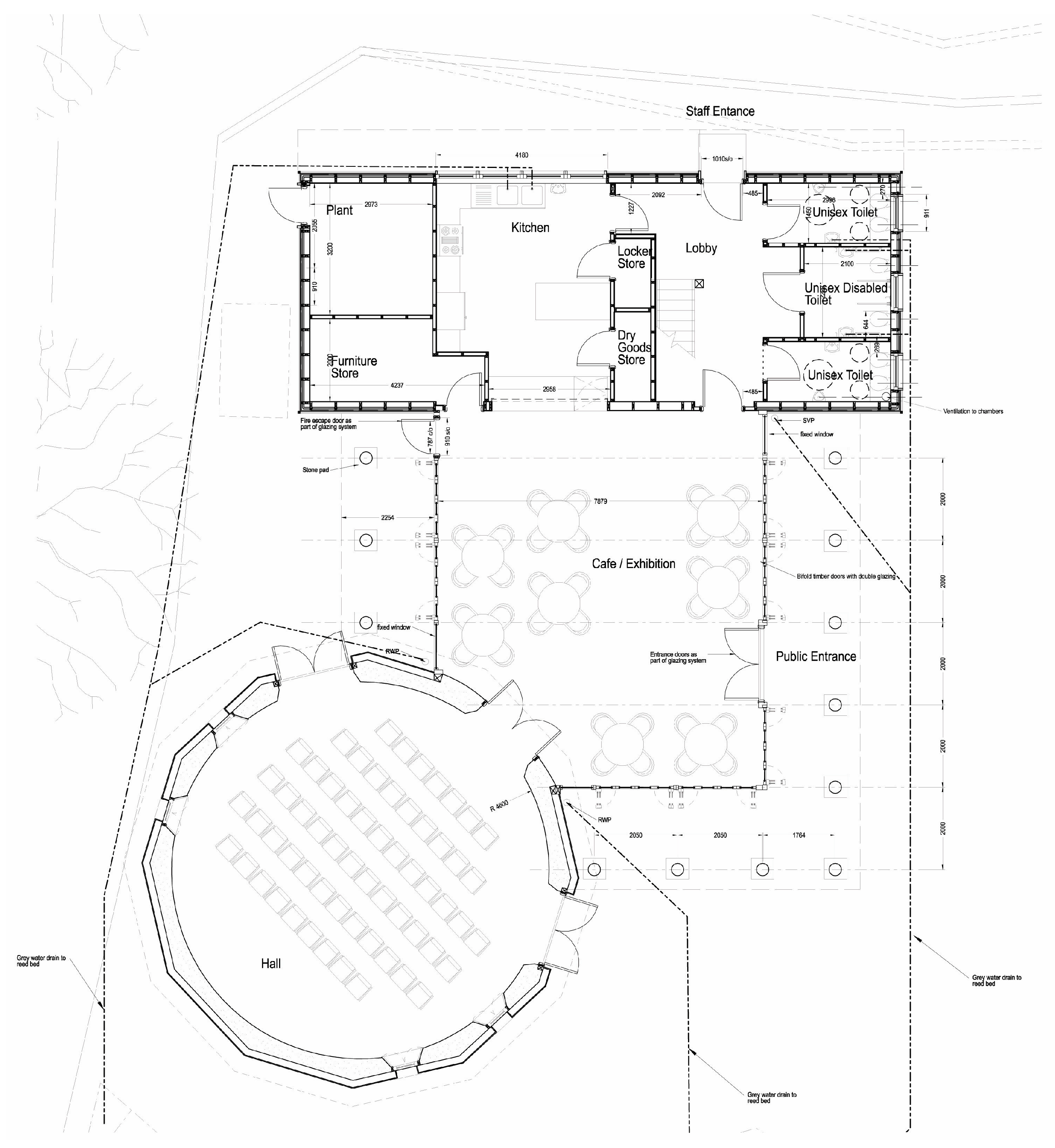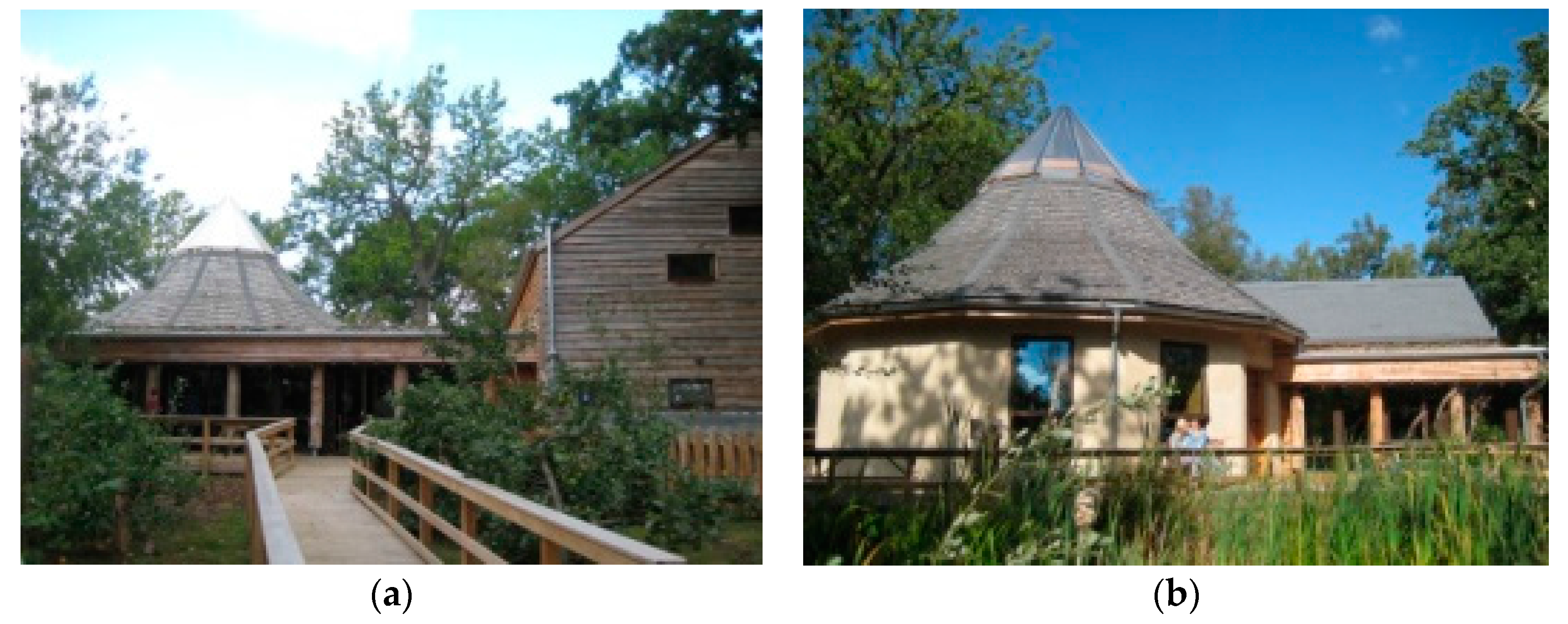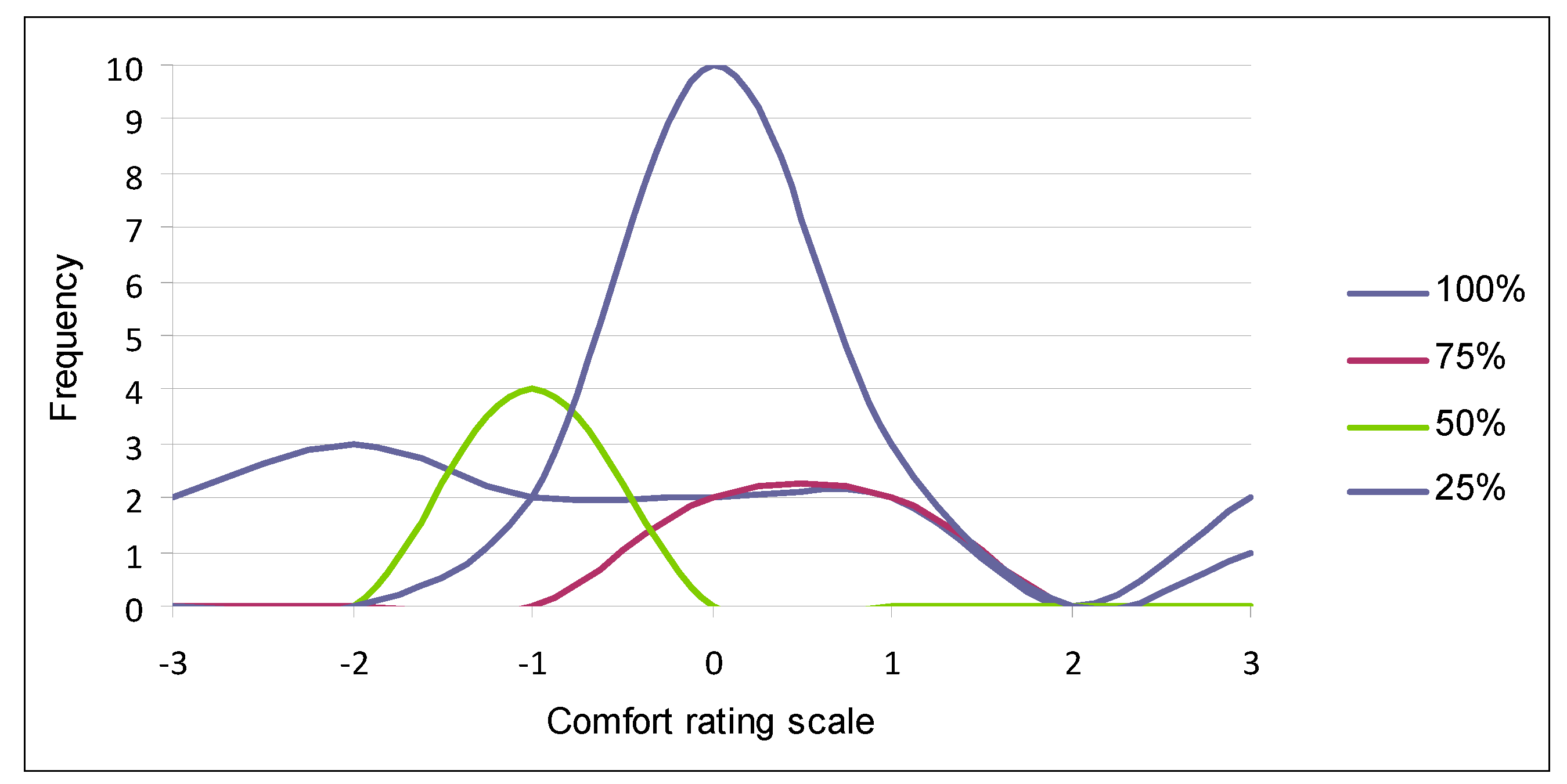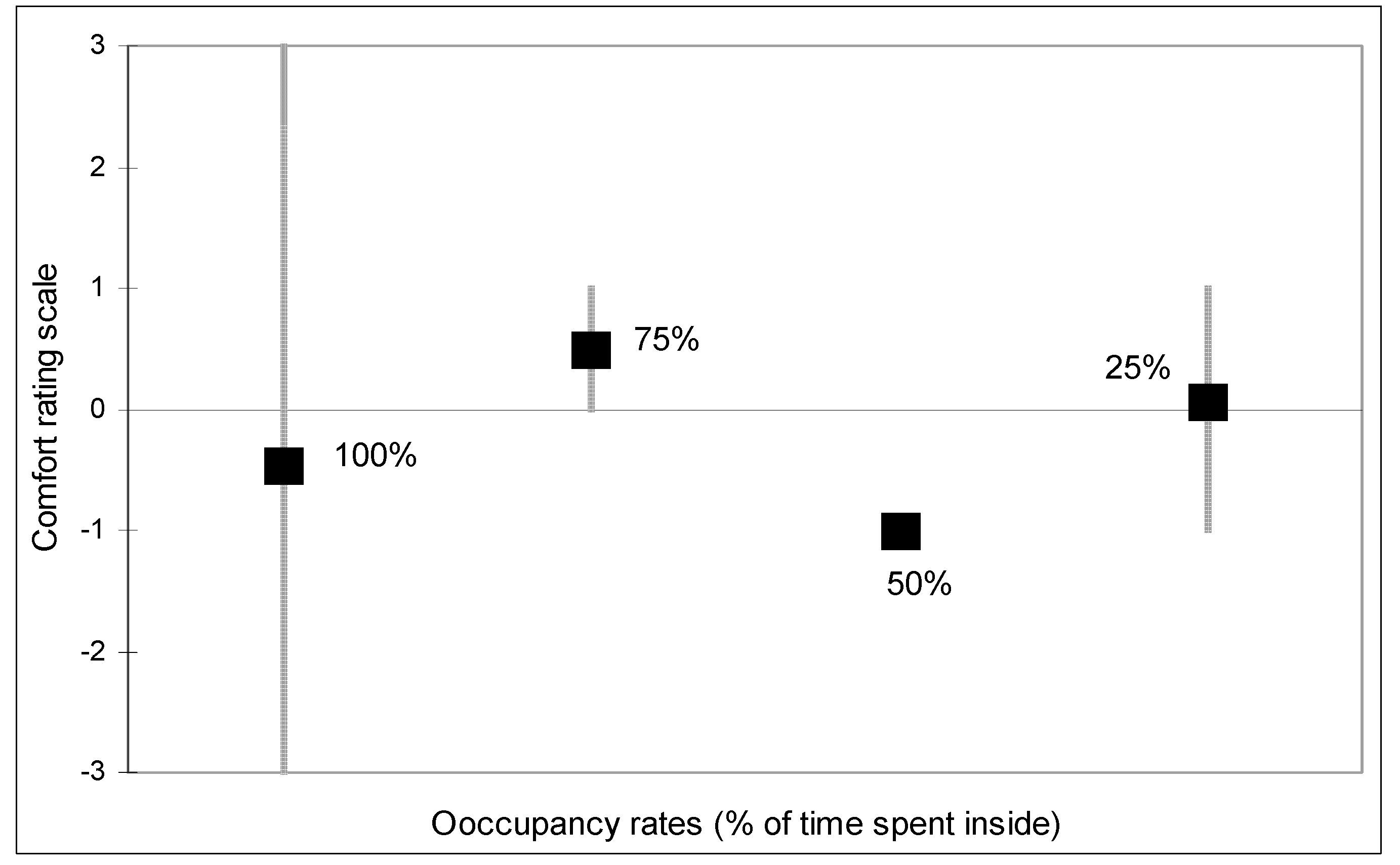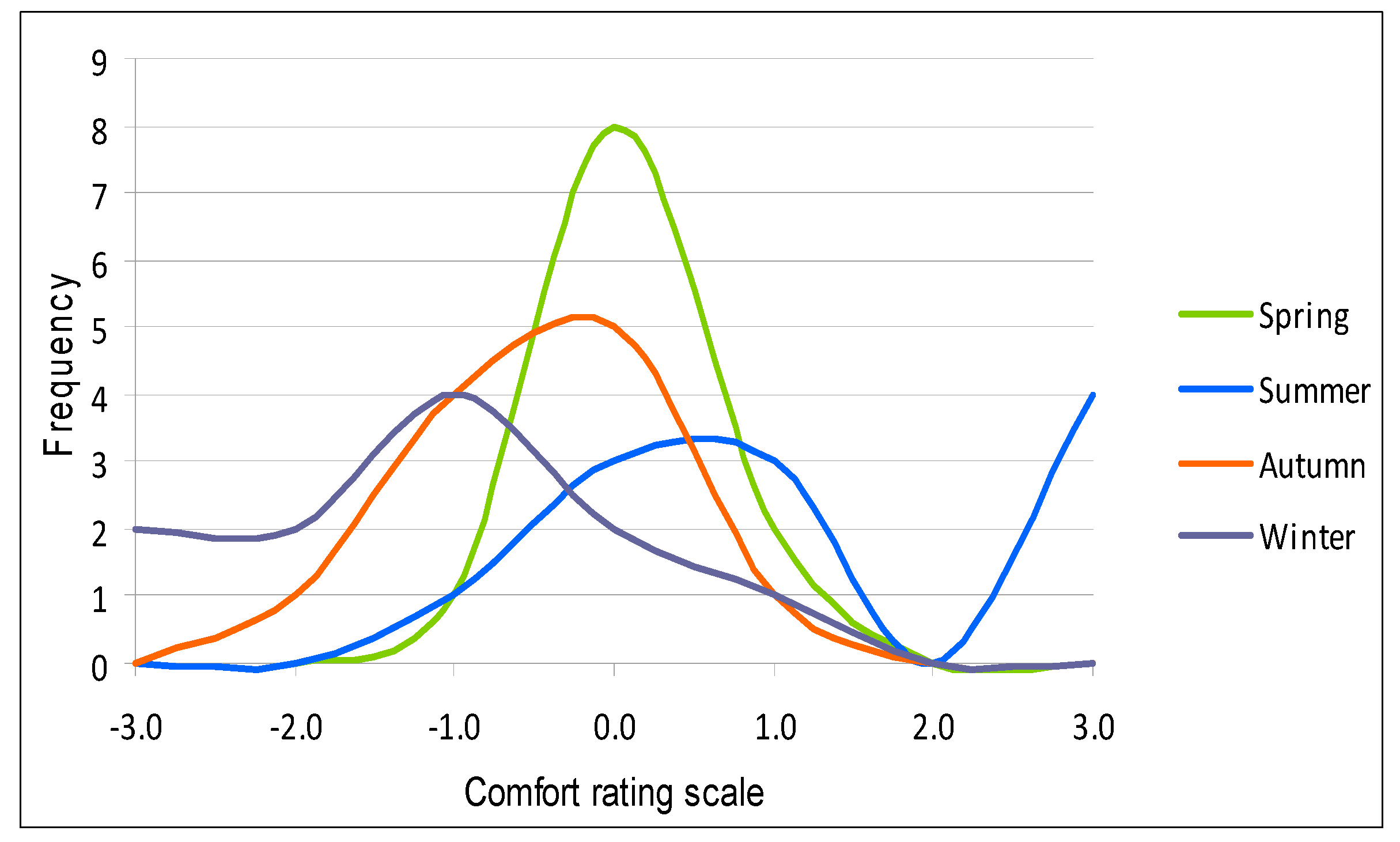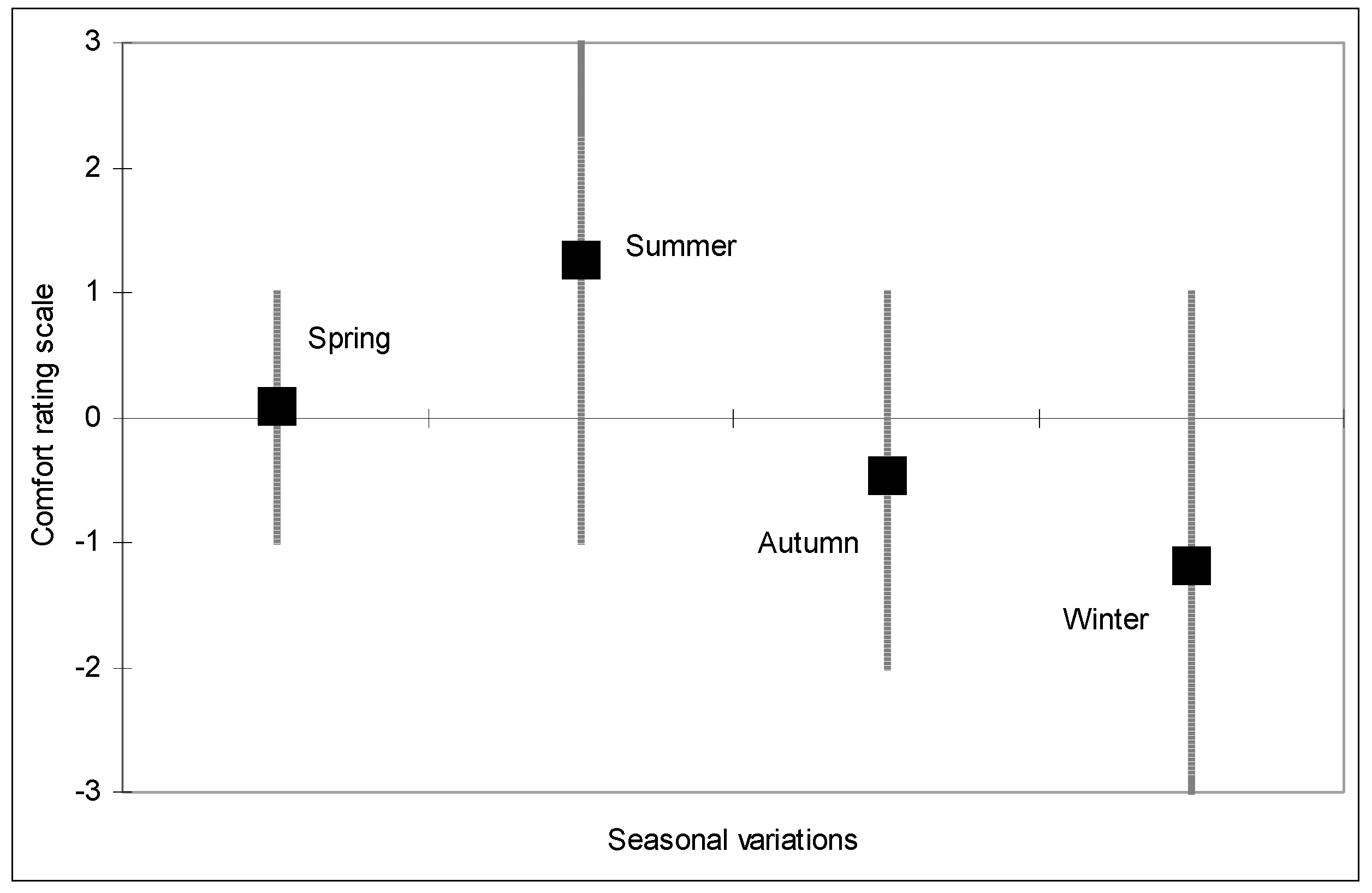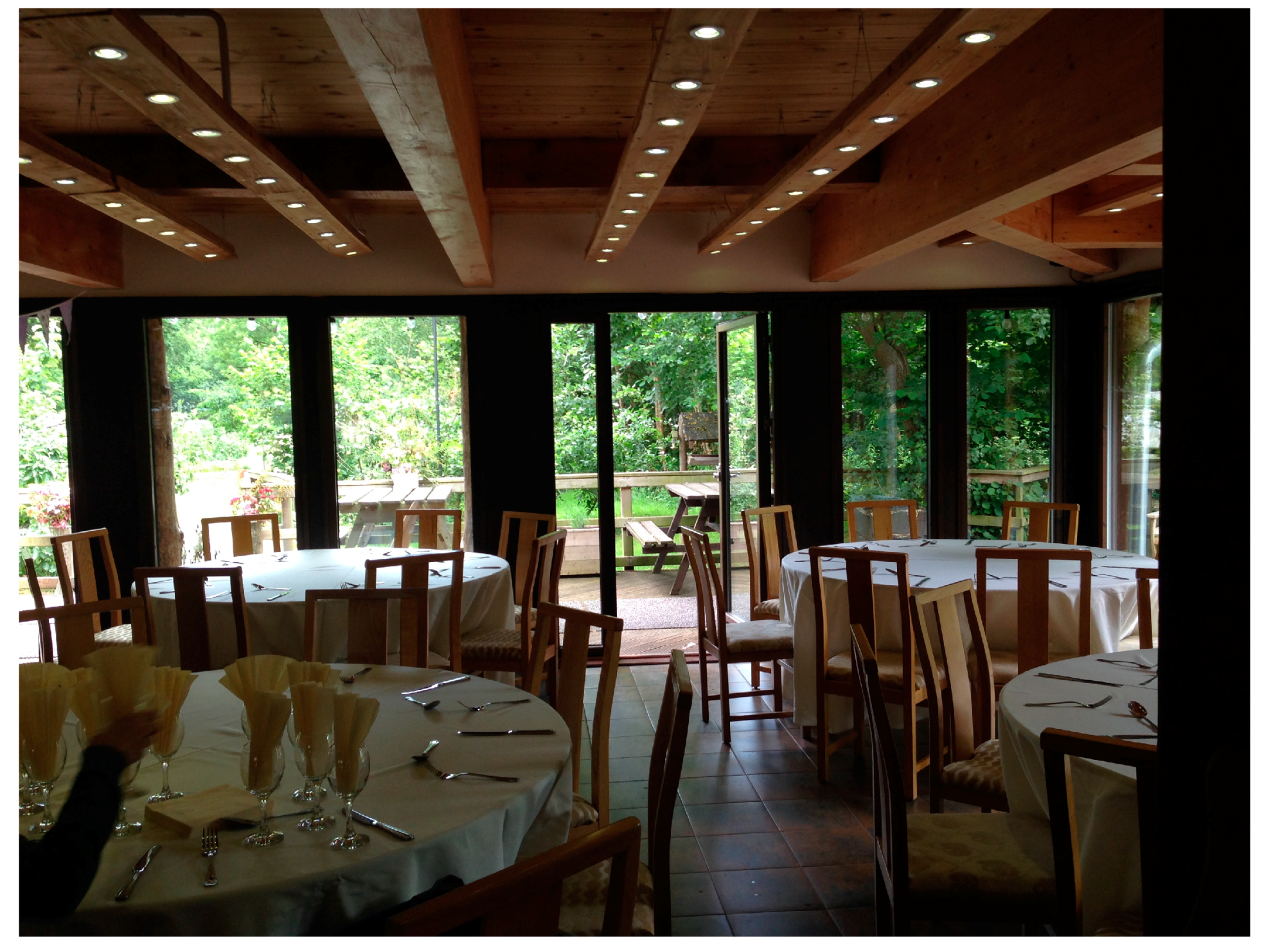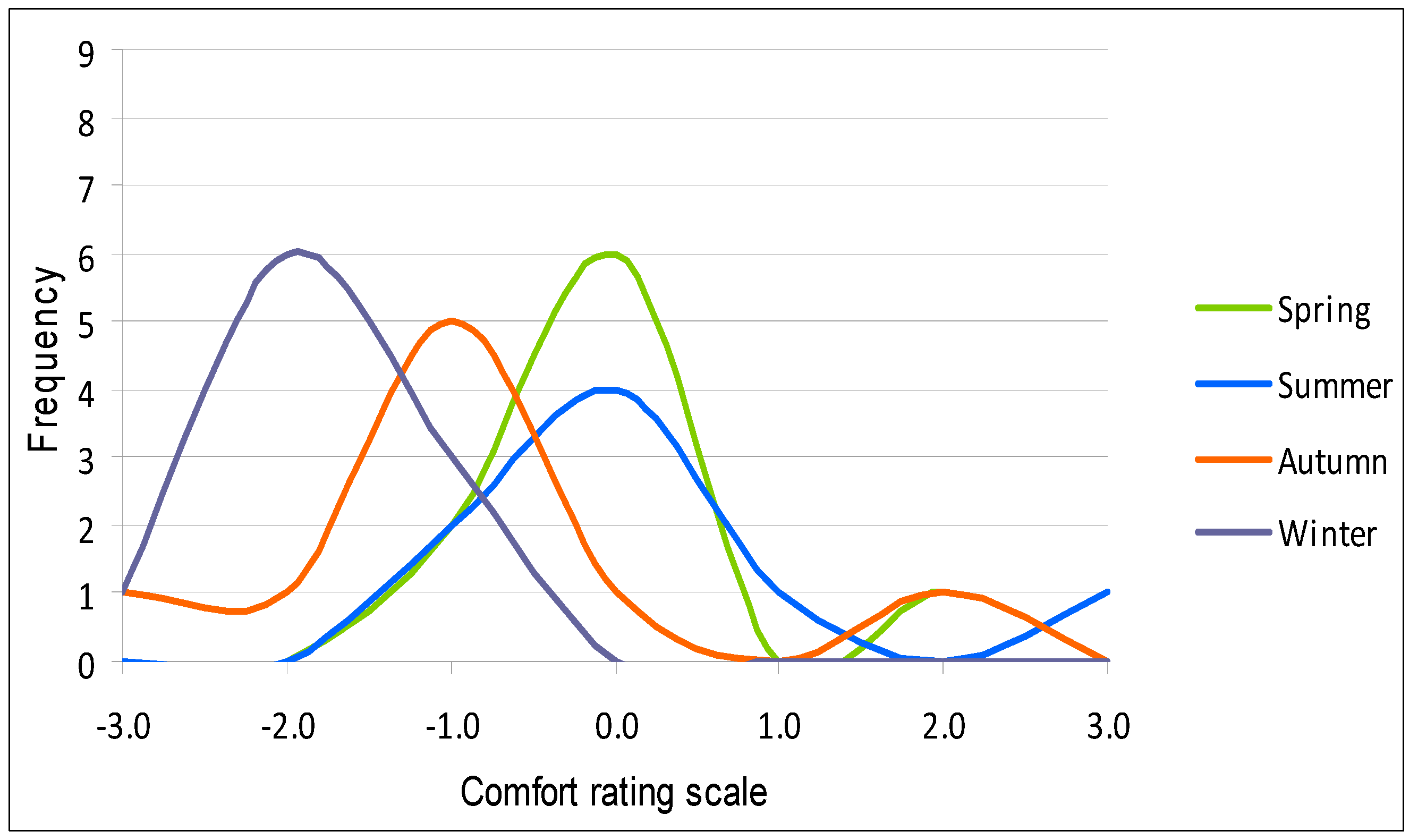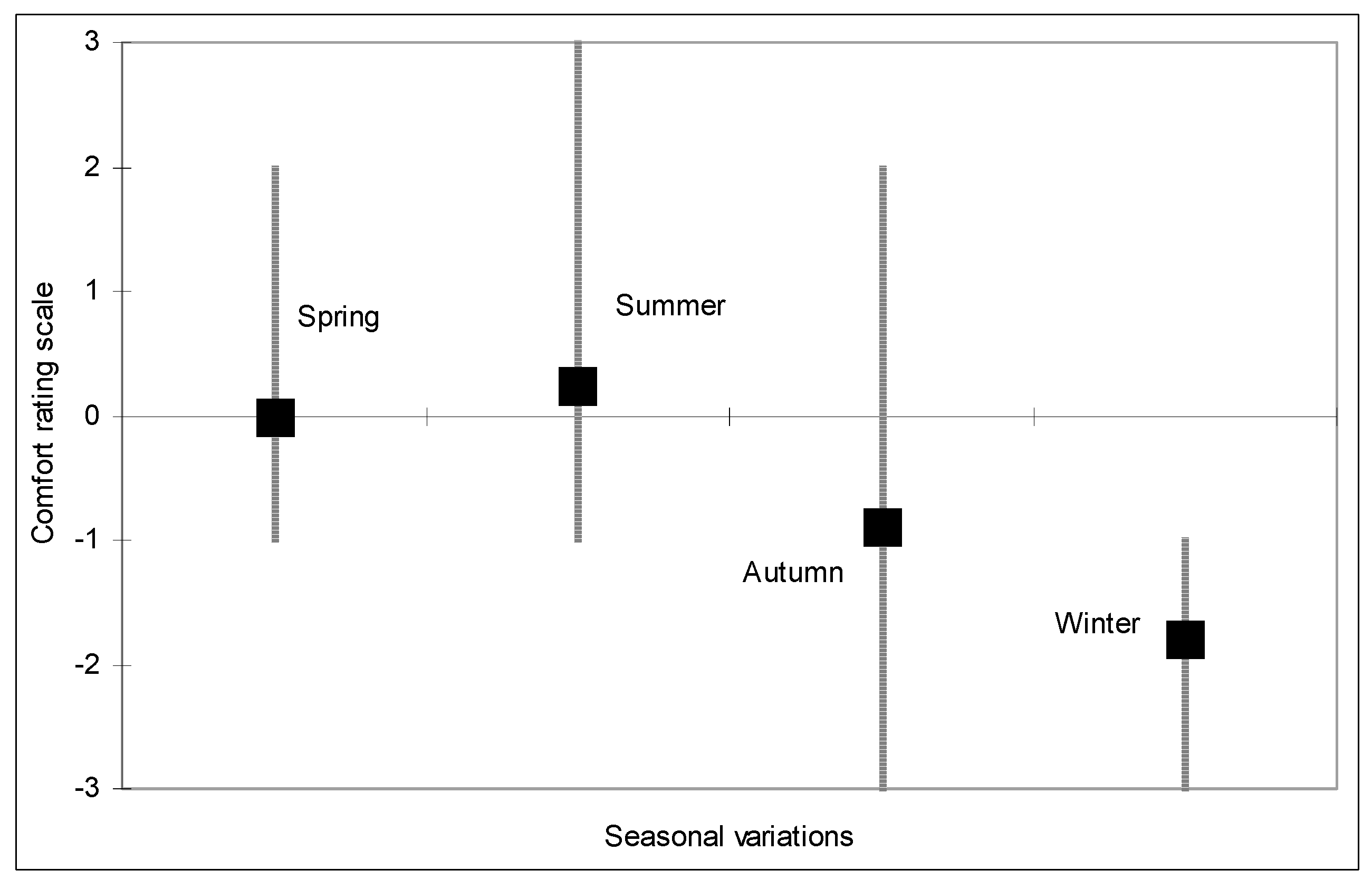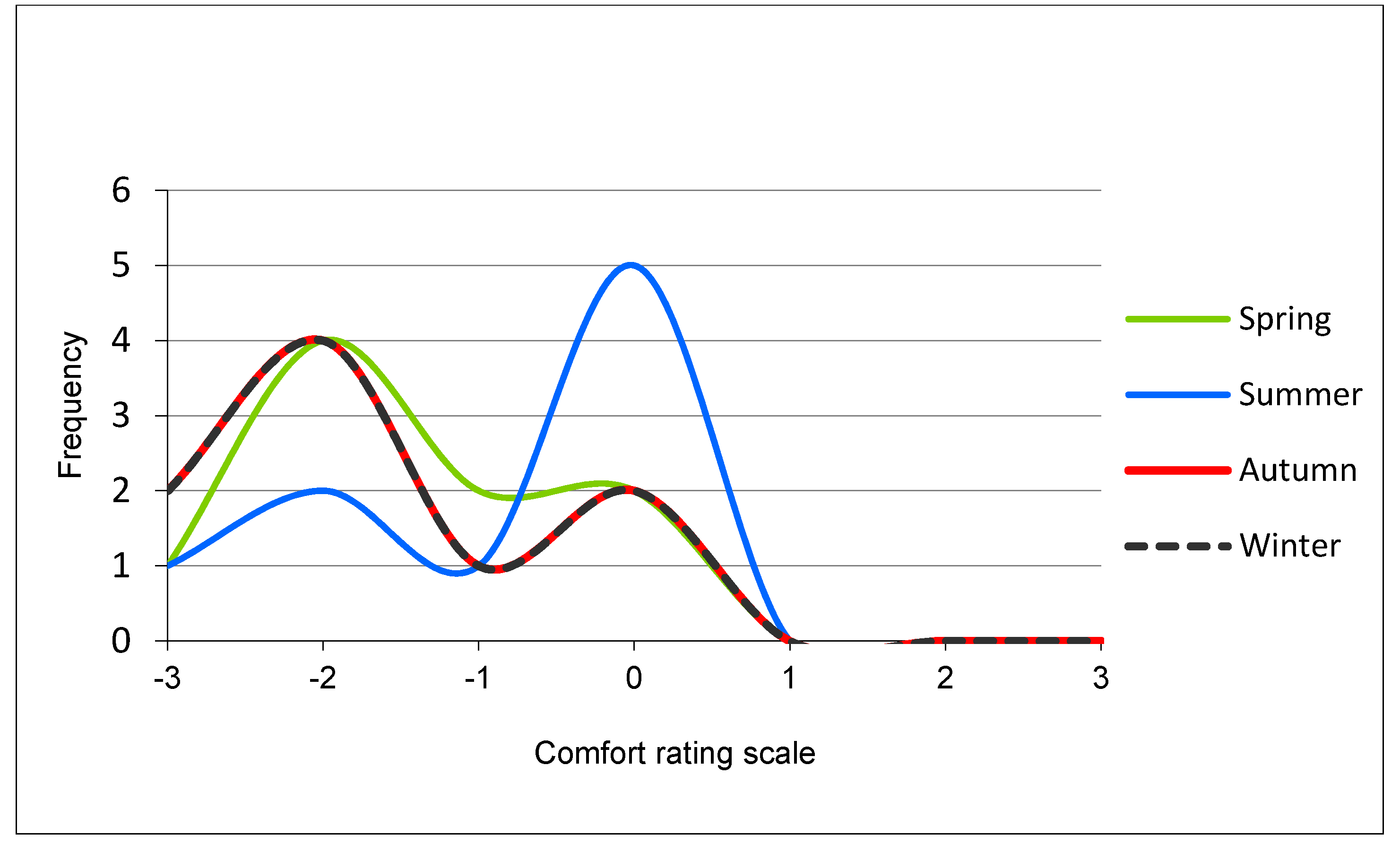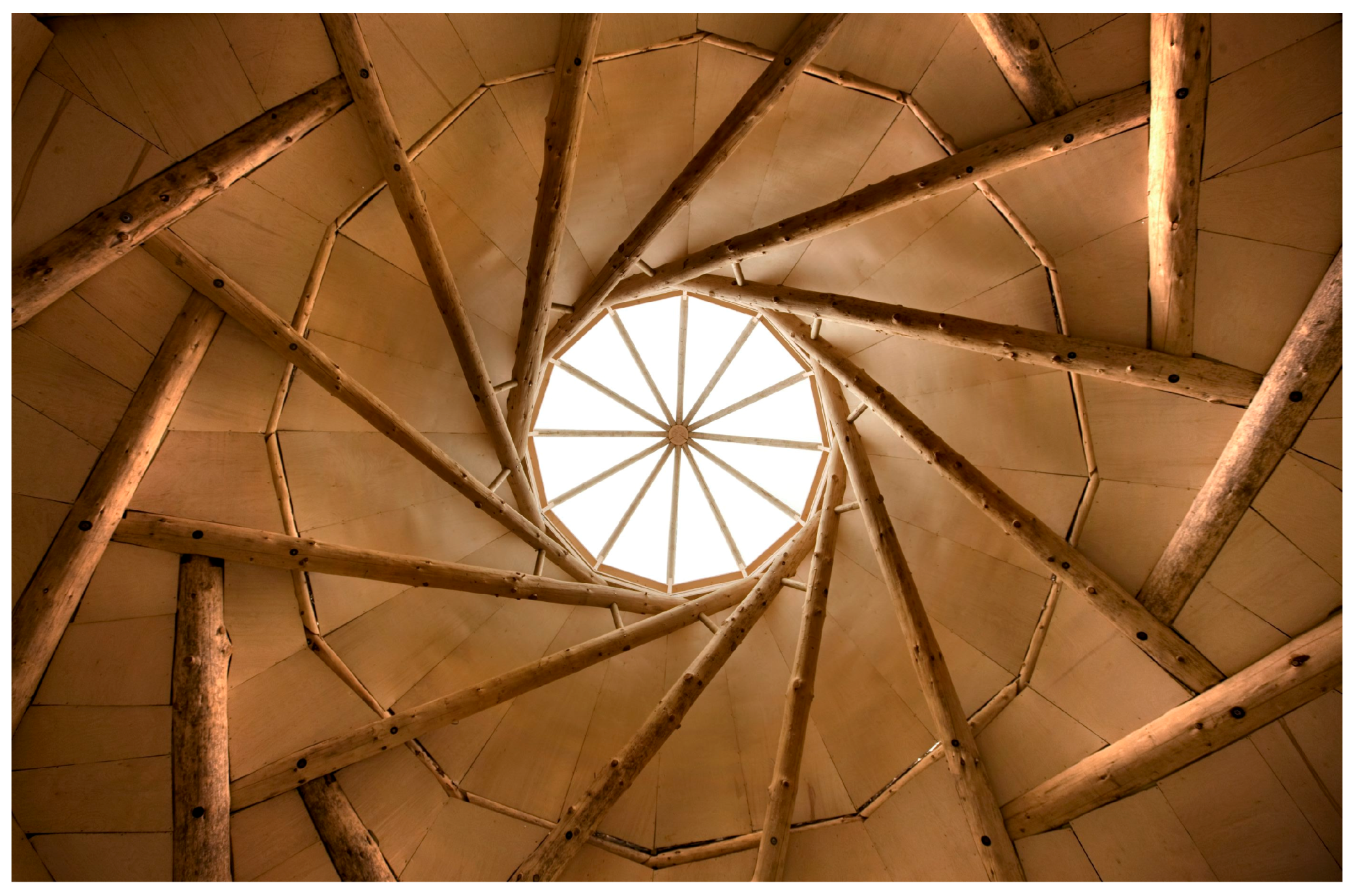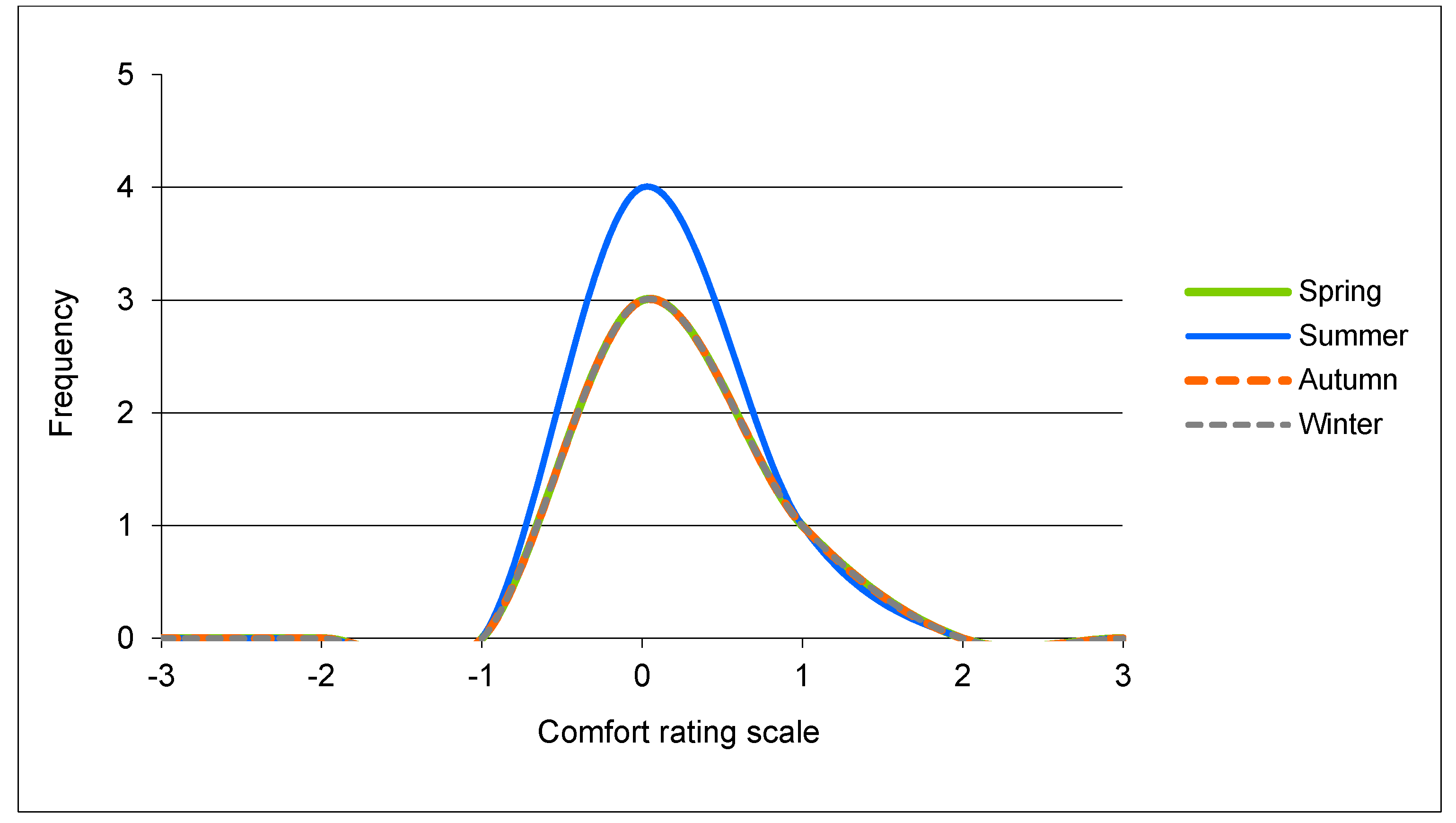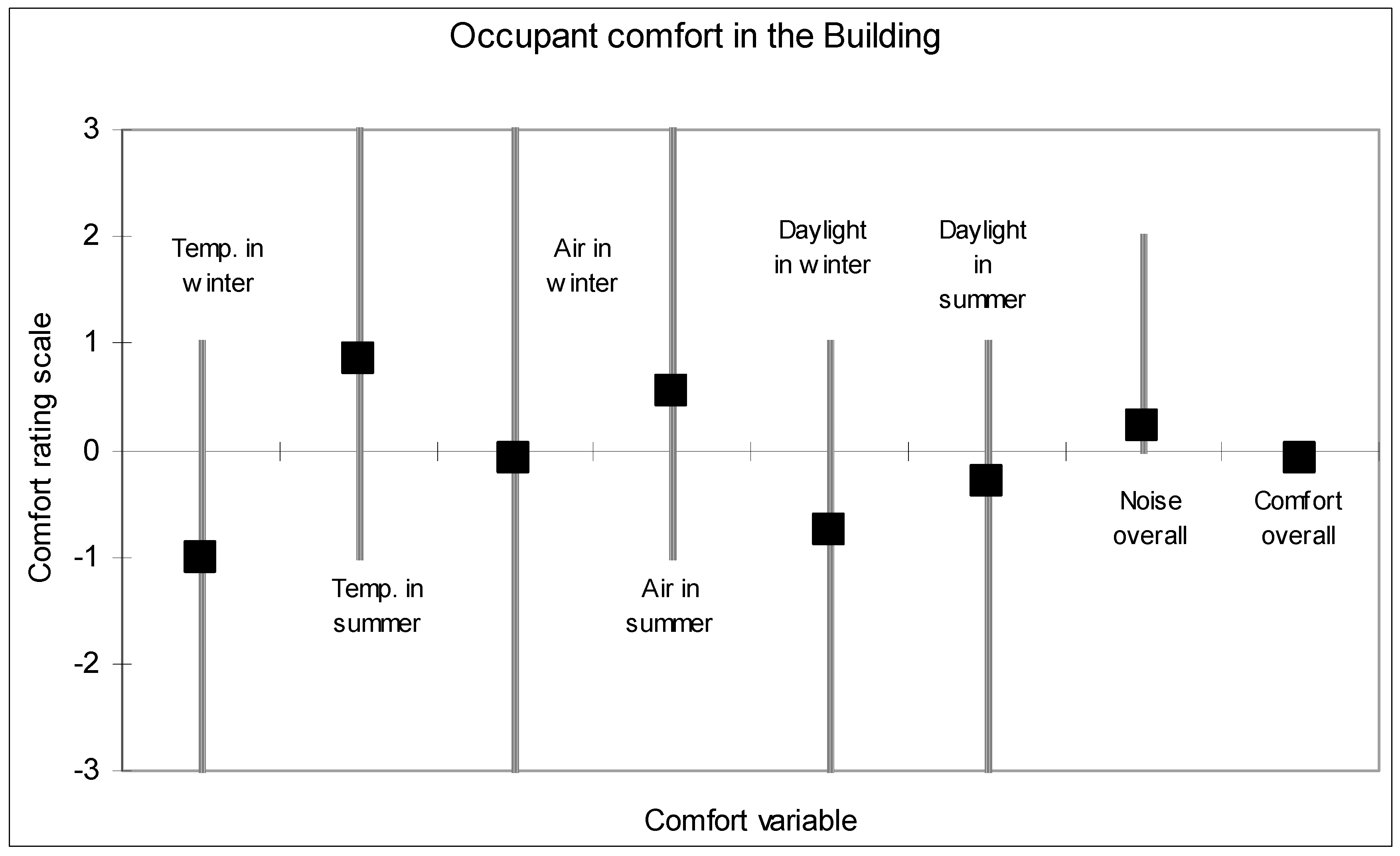1. Introduction
Post-occupancy evaluations of buildings provide invaluable insights into the environmental performance and user behaviour of buildings.
The information obtained from a POE can be used for fine-tuning the building’s operation to enhance its performance. The information is also useful for regulating the internal environment of the building to enhance user comfort, wellbeing and satisfaction [
1,
2]. The wider aspects of performance measured by a POE can address issues such as space utilization, management, environmental impact and cost in use [
3]. The POE can also be used as a learning loop to feed-forward lessons learnt to better inform the decision-making process at the design stage [
4].
Most post-occupancy user satisfaction evaluations reported in the literature are about conventional large workplaces. They do not adequately cover special cases, for example off-grid workplaces, or cases where there has been heavy involvement of end users in the design and construction of the building. This paper analyses the comfort and satisfaction of users of a naturally-ventilated off-grid building where users were involved in its design and construction. The building users are also heavily involved in controlling the environment of the building and have a tendency to adapt to changing conditions in their environment. In such conditions, as suggested by Nicole and Humphreys [
5], the users’ natural tendencies are expressed in their adaptive approach to thermal comfort. Their participation in the procurement of the building and in controlling the environments they inhabit, support the idea that such an approach can result in a wider acceptability of the environmental conditions of the building.
The findings of the paper are of interest for sustainable workplaces where there is emerging interest in employee wellbeing as an indicator of business performance within a context of environmental comfort analysis of the buildings they occupy.
Aims and Objectives
This research aims to identify and test how building user satisfaction may be influenced by parameters such as:
Occupant engagement and the management approach to maintenance and comfort control;
Occupant knowledge of the building being low energy and green; and
Other influences which affect occupant satisfaction beyond the internal environment.
2. Research Methodology
The research adopted a field survey method to evaluate comfort and satisfaction of people using a pilot building. In our post-occupancy evaluation (POE), as recommended by Nicol et al. [
6], through a series of questions we attempted to analyse how building users felt in different parts of the building throughout the course of the year. In other words, the building users were prompted to provide a subjective measure of the building and act effectively as its ‘memory’ [
7]. The survey asked questions such as: How have you found the temperature in different parts of the building in different seasons? Or: How much time do you spend in different parts of the building in different parts of the year? etc.
In our performance evaluation of the building, we were solely concerned with users’ comfort and satisfaction. In the questionnaire, building users were asked about their experience of the building regarding a range of internal conditions in different parts of the building such as air temperature, humidity, air movement, air quality, daylight, artificial light, and noise. Our emphasis was on measuring the performance of the building through the impressions of its occupants as opposed to through the measurement of the physical characteristics of the environment (temperature, noise, light, etc.). As Nicole and Roaf [
7] suggest “…the recording of the instantaneous physical environment is not the issue so much as the evaluation of the overall performance of the building and the impressions of its occupants that contribute one measure of its success”.
The survey was carried out in 2015 after a period of occupancy. The questionnaire consisted of 31 questions covering all the main dimensions of environmental and spatial quality of the buildings in different seasons of the year. Environmental quality questions were formulated based on the commonly used seven-point psycho-physical scale developed by the American Society of Heating, Refrigerating and Air-Conditioning Engineers (ASHRAE) as a measure for the comfort sensation [
8], for example with regard to temperature (−3 = very cold), (0 = optimum) and (+3 = very hot); and air movement (−3 = very draughty), (0 = optimum) and (+3 = very stuffy), etc. Respondents were not offered any incentive to participate. The results of the survey were presented to several office workers for discussion, which offered some further insights into the user’s understanding of their own perceptions of comfort and satisfaction.
3. Post-Occupancy Evaluation and Comfort Modelling
One generally accepted definition of thermal comfort is that of ASHRAE [
8], suggesting “that state of mind which express satisfaction with the thermal environment”. Different models and indices have been developed to predict the thermal comfort and satisfaction of building users. Broadly speaking, there are two main approaches for analysing the thermal comfort and satisfaction of the occupiers of buildings. The first one is the analytical approach, and the models developed based on this methodology are usually referred to as “rational” or “heat balanced” models [
6]. The second method, which has recently attracted considerable attention, is the “empirical approach”, also referred to as the “adaptive approach”, which is based on field surveys and POEs [
6,
9].
The analytical approach and its heat-balance-based models employ principles of physics and physiology, using the heat flow mechanisms of the body together with the effect of external factors to keep the core temperature of the body around 37 °C. The physical properties of an environment affecting thermal comfort include air temperature, mean radiant temperature, air velocity, and humidity. In addition to these environmental factors, one’s comfort is also affected by two individual factors, being activity level and clothing.
The best-known heat balance models are predicted mean vote (PMV) [
10] and standard effective temperature (SET) [
11]. The PMV is particularly important because it forms the basis of most national and international comfort standards, e.g., ISO 7730 and ASHRAE 55. Fanger [
10], based on experimentally-determined physiological comfort criteria and heat transfer theory, derived the comfort equation using the combination of the six environmental and individual factors. In addition to PMV, which gives the predicted mean vote of a large group of people exposed to a controlled environment (laboratory), Fanger also developed the predicted percentage dissatisfied (PPD), which predicts the degree of discomfort and the percentage of the group who will express discomfort. Fanger used the commonly-used seven-point psycho-physical scale as a measure for the comfort sensation for different environmental variables affecting comfort.
The heat balance approach and models based on it, e.g., PMV, may pose a number of problems for environmental designers due to unknown factors such as the actual clothing occupants may wear and the actual levels of their activities [
6]. In addition, the conditions in real buildings may differ considerably from the steady state conditions in the laboratory settings that these models are based on. Nicole et al. [
6] suggest that “thermal environment standards derived from the laboratory-based models will typically only be applicable to highly serviced buildings that are capable of producing closely controlled indoor climates in a wide range of outdoor temperatures”. They also suggest that “based on field studies result people worldwide accept a much more diverse set of thermal environments than laboratory-based indices lead us to expect, because people have adapted to their own particular climate” [
6].
Where buildings are expected to operate in free running modes (no heating or mechanical ventilation needed), models developed based on analytical approaches can not accurately represent conditions. This has necessitated the development of another approach which is based on surveys of people’s response to the environment using statistical analysis from field surveys. Nicol et al. [
6] suggest that “if we want to know how people feel in a particular situation there is no better way to find out than to go and ask them”. This method of the field survey provides the basis of the adaptive approach and the models developed based on this approach are called ‘empirical models’.
The heat balance approach mainly relies on mechanical systems such as air-conditioning for the provision of comfort. On the other hand, the adaptive approach seeks a wider form of comfort and wellbeing in a more natural environment. Haigh [
12] suggests that this approach generally provides a broader band of conditions, but with better outside awareness and facilities for discomfort-alleviation. In some cases, it is possible to adopt both approaches where appropriate, by using a mixed-mode concept combining for example natural ventilation with mechanical ventilation and/or cooling systems [
13].
The adaptive approach, as explained by Nicol et al. [
6], is mainly based on empirical observations in which the adaptive mechanisms operated by individuals, e.g., opening and closing windows, may be predicted to achieve comfort. The behaviour of occupants and their interventions in regulating the internal environment they occupy are the most effective measures in the provision of comfort and wellbeing. Nicol et al. [
6] quote that “a most powerful form of human thermoregulation is behavioural—putting on or taking off clothing, changing posture, move, take shelter, etc.” The increasing interest in the adaptive approach has resulted in the ASHRAE Standard 55, Thermal Environmental Conditions for Human Occupancy, including a new adaptive comfort standard (ACS), that allows higher internal air temperatures for naturally-ventilated buildings during summer [
14].
4. User Study
The study focuses on a POE of a sustainable building operated by Hill Holt Wood Social Enterprise. The Social Enterprise operates in a 34acre woodland. The woodland is managed as a habitat to be conserved, but also looking to the future and utilising natural resources to achieve employment, education and training goals. Hill Holt Wood (HHW) is a centre for learning for a diverse range of learners of all ages and abilities who may be at risk, excluded from education, or unemployed. In addition, the building is used regularly for events such as conferences, workshops, wedding parties, and other community activities.
The building was designed to be off-grid and built to enable maximum participation of users in the actual construction process. The building complied with Part L 2006 of the UK Building Regulations. The building is off-grid with a centralised energy distribution system for heat and power with variable fuel sources. The energy distribution system also caters for a number of small buildings and operational demands on the site including catering, a sawmill and craft workshops, other small offices, a bunk house, a gallery, and meeting spaces
The building was designed through a two-year Knowledge Transfer Programme (KTP) research project [
15] during 2005 to 2007 to meet three main aims:
To demonstrate sustainable building materials and passive design strategies;
To enable employees and trainees to develop practical construction skills; and
To provide a centre for community events, business meetings and conferences.
Sustainability
The design of the building is based on the principles of passive solar design utilising natural light, ventilation, thermal mass and insulation [
15]. The building is multi-functional and split into three use groups. These are the round rammed earth hall with a reciprocal timber roof; the link, with a green roof housing the café and exhibitions; and the box, housing the plant, kitchen and services on the ground floor and offices on the first floor. The box is constructed with highly insulated timber.
One main aspect of the environmental design of the building was to create a low energy sustainable building. The hall, facing south, is made of rammed earth walls to offer thermal solar storage. On the other hand, the office block, facing north and shaded by mature trees, is a highly-insulated timber frame structure.
Figure 1 shows an early design sketch exploring the citing of the building on the site.
Figure 2 and
Figure 3 show the ground floor and first floor plans of the building as designed.
Figure 4 shows images of the completed building.
The building is highly insulated, achieving very low U-values. The U-value of the rammed earth wall of the hall is 0.18 WK/m
2, while that of the office block is 0.08 WK/m
2 [
15]. The roof U-values are of the order 0.08 and 0.09 WK/m
2 for the office and the hall, respectively [
15]. The U-value of the ground floor, entirely made of reinforced limecrete, is 0.19 WK/m
2 [
15].
The estimated heating consumption of the building at the design stage using computer simulation was 23 KWh/m
2/year [
15]. This was better than the heating demand for “good practice” community centres at the time, which was reported to be in the order of 125 KWh/m
2/year, while that for “typical practice” was 187 KWh/m
2/year [
15].
The primary driver for the building was that it should be low carbon in both construction and use. Resource use was intentionally very low carbon, using local materials; rammed earth walls; Hemlock split cladding; roundwood structural timber drawn from the forests managed by HHW and seasoned on site; timber shingles hand split on site; and a floor mosaic created by a local arts group. Innovative materials included Limecrete foundations using aggregate from the nearby quarry (at the time it was the largest reinforced casting in England) and multilayer foil insulation. Recycled materials included insulation from plastic bottles used in the pitched roofs, and recycled plastic slate effect roof tiles. Renewable materials included cork insulation for flat roofs and some walls; an engineered timber structure for the office certified by Programme for the Endorsement of Forest Certification (PEFC), which used thinnings from forestry management to create beams, studs, timber windows, and doors; glulam structural beams fabricated in Hull (50 miles away) and roundwood off-cuts for low-energy light fittings in the café area.
The assessment of the burden of the embodied materials revealed that the material emissions rate for the building is of the order of 332.27 kg CO
2/m
2 [
15]. This estimated design value was much less than that for a conventionally constructed building with a similar function, at 800–1200 kg CO
2/m
2 [
15].
Whole life cycle assessment (LCA) was carried out at the design stage to estimate the burdens of all life stages of the building including project management, materials, the construction process and waste, in-use energy, and finally the deconstruction stage. The whole life emission of the building over its life span was estimated to be of the order of 150 t CO
2 or 440 kg CO
2/m
2 [
15], much less than conventional buildings.
The sustainability credentials of the building were communicated with all stakeholders involved in the design and construction of the building, some of whom are still using the building. The fact that the building is the recipient of a range of sustainability awards has also raised the awareness of its users of its green credentials.
5. User Comfort Survey Analysis
The building is designed and operated based on the concept of adaptive comfort. The adaptive model of comfort, which is usually used in naturally ventilated buildings, is based on the principle that if a change occurs in a building so as to produce discomfort, people react in ways which tend to restore their comfort [
16]. Such a shift has also been magnified by the desire to shift to a lower-carbon society by moving away from energy demanding conventional systems, to a broader notion that takes into consideration dynamic, integrated, and participatory aspects [
17].
The three distinct components of the building, i.e., the offices, the canteen and the rammed earth hall, have different operational modes and requirements. It is hence assumed that users may take different measures to regulate the internal environments of these spaces. In addition, each part has its own characteristics: the offices are thermally light, facing north; the rammed earth hall, with its considerable thermal mass, facing south; whist the canteen is highly glazed to increase the notion of transparency. As a result, in addition to different usages, the thermal characteristics of the different parts of the building affect and demand different interventions to regulate the internal environments. The building sits in a special woodland environment. As a result, it is expected that the comfort and its provision will be influenced by the context within which the building and its activities take place [
18,
19,
20].
The questionnaire we used in our survey required information based on the seven-point psycho-physical scale (−3 to 3) for different comfort variables as summarised in
Table 1. Correspondents were also asked to record their votes for different variables for different parts of the buildings (the offices, canteen, and the hall) and for different seasons (spring, summer, autumn and winter). For noise, the questions did not include seasonal variations.
A total of 700 votes were cast covering all variables on the seven-point scale for the whole building throughout the year.
Table 2 lists the number of votes (frequency) for different rating scales. The majority of votes are (0) indicating optimum conditions, this corresponds to 67.4% of the votes.
Figure 5 depicts the overall distribution of votes over the rating scale. Although votes were cast for the extreme conditions (−3 and 3), indicating severe discomfort, their frequencies were small.
In addition to the internal conditions that affect the level of user satisfaction with different comfort-related variables, it has been reported that people are usually happier in smaller buildings [
21]. From the field surveys, it is also reported that people are more tolerant of green buildings [
21,
22,
23]. These two notions apply to the building. The users’ knowledge of the green credentials of the building and the fact that they are working in a small building should have favourably affected their level of satisfaction.
Leaman and Bordass [
21] claim that users tend not to worry about comfort as such, but rather discomfort, and they react when a ‘crisis of discomfort’ has been reached. They also suggest that individuals have different tolerance thresholds and respond differently and at different times, taking different measures to restore comfort. Users of the building have a good level of control over their building. The building has been developed in a way to enable users to have a high level of ownership of the design and building fabric. Although some of the individuals who initially led this process in the organisation have since moved on, there is a collective sense among the current users that the building represents an off-grid sustainable green building. Such a perception is believed to have favourably influenced the level of satisfaction experienced by users [
21,
22,
23,
24].
Leaman and Bordass [
21] claim that in buildings where control over environmental conditions have been removed from users, people are less tolerant of discomfort conditions. Bordass and Leaman [
3] also suggest that in contrast, in buildings where users have a clear understanding of how the building works and can control internal conditions through measures such as opening/closing windows, changing thermostat settings, etc., are more tolerant if things do not turn out quite as well as they should. They also suggest that as far as occupant perceptions are concerned, the influence of the building, its systems and its management are inseparable.
6. Sources of Dissatisfaction and Satisfaction
6.1. Air Temperature
Leaman and Bordass [
21] have reported that in summer users usually say that naturally-ventilated buildings are too hot, while they complain that they are too cold in winter. Humphreys and Nicol [
25] have reported that people usually become more tolerant of warmer environments compared with the case a generation ago.
Offices in the building are thermally light, with a highly-insulated timber frame construction. There are nine users working in the two office spaces. The larger office is a shared open plan office with a hot desk arrangement (
Figure 6), while the smaller office is a private office used only by one person. The partitions originally designed to provide storage spaces for the offices, as shown in
Figure 3, have not been installed to maximise office floor areas.
Figure 7 depicts the responses of the office workers for the air temperature throughout the year, spending different amounts of time inside their workplace. Office workers in this building have different roles, some for example are rangers who spent parts of the day outside the building in the woodland. The results suggest that those who have more opportunities to benefit from the natural environments surrounding the building have enhanced perceptions of satisfaction. The results show that those who spent the least amount of time inside (25%) have scored the maximum number of votes for the midpoint 0 (optimum condition). The mean vote for this category of staff, as shown in
Figure 8, is very close to neutral (0), being 0.07, with the rating scale ranging from −1 to 1. For the four users who spend 50% of their time inside, they all rated the internal conditions at −1 on the rating scale. For those with 75% occupancy, the rating ranges from 0 to 1 with a mean vote of 0.5. For 100% occupancy, the range spans from one extreme to another on the rating scale, i.e., from −3 to 3. The mean vote for these users was of the order of −0.46.
6.2. Workplace Environment
The building is set in a mature broadleaf woodland benefiting from many natural features and points of interest. Some of the workers spend part of their day outdoors and have the ability to see the woodland through numerous windows. Abbaszadeh et al. [
26], in their analysis comparing green with non-green buildings, have concluded that occupants in green buildings were more satisfied with thermal comfort and air quality in their workplace. From the results of their survey they however concluded that the average satisfaction scores for lighting and acoustic quality were comparable to those in non-green buildings. Similar results were also found by Armitage and Murugan [
23]. In their survey of ten green office buildings and eleven non-green office buildings, they found that employees in green workplace environments consider themselves to be happier and healthier than employees in non-green workplace environments. The office workers in the building in this study are fully aware of the sustainability credentials of the buildings and hence this awareness may have favourably influenced their satisfaction with the indoor air temperature of their workplace.
Figure 9 shows the influence of the seasons on the comfort sensation regarding the air temperature in the offices. The results confirm cases reported in the literature that in naturally-ventilated buildings some users find it too hot in summer (four users voted 3) and cold in winter. Spring and autumn had the lowest mean votes, 0.091 and −0.455 respectively. On the other hand, summer and winter had mean votes of 1.273 and −1.182 respectively as shown in
Figure 10.
Large windows are provided in the canteen to provide views out (
Figure 11). Those who spend less time inside the canteen are happier and there is a tendency for finding the space to be hot for those spending more time inside (
Figure 12). Although there are some sensations towards the hot end of spectrum, there are no complaints as such about the space being cold. This could be due the higher activity levels in the canteen, as well as higher internal heat generation, e.g., due to food preparation.
The hall is a thermally heavy construction made of rammed earth. It is mainly used for events, so its use is intermittent throughout the year. As shown in
Figure 13, the temperature ratings in the summer are evenly distributed around the midpoint of 0 (optimum conditions), with only one vote expressing that the internal environmental conditions are hot (rating of 3). People however found the space to be cold in autumn and winter.
The mean temperature votes for the hall for spring and summer are close to the midpoint of 0, indicating that a good overall indoor environment is achieved, being of the order of 0 and 0.25, respectively (
Figure 14). The mean votes for autumn and winter are of the order of −0.889 and −1.8, respectively, indicating that the overall sensations are towards the cold spectrum of the rating scale.
6.3. Daylight
The addition of the storage spaces to the working area in the offices has resulted in less average daylight factor and poorer light distribution due to the increased depth of the offices than was planned in the original design. Survey results confirm that users feel that the offices are under-lit throughout the year, as shown in
Figure 15. The corresponding mean votes were −1.444 for spring, −0.889 for summer, and −1.667 for autumn and winter.
On the other hand, it seems that the hall, due to its openings and especially the roof light in the reciprocal roof (
Figure 16), benefits from an adequate level of natural light throughout the year, as depicted in
Figure 17. The majority of votes were around the midpoint, indicating good level of daylight.
Similar analyses were carried out for other variables listed in
Table 1.
Table 3 lists percentile scores for optimum conditions (midpoint 0) and the ratings deviating from the midpoint in the offices for users spending different amount of time in offices. The table also shows the mean votes.
Table 4 similarly lists the results for the whole buildings.
Figure 18 shows the range and mean values for different variables for the whole building. The overall comfort is close to the optimum midpoint (−0.066). This rather good overall satisfaction with the building may have also been influenced by the varied environments existing in the building, as suggested by Heschong [
27].
7. Conclusions
In this building, it is clear that many of the regular users have a partly outdoor role and this changes their perceptions of comfort. The office workers who commented on the results felt that they had a unique perspective on comfort in their workplace, primarily because they had chosen to work in the woodland environment and tolerated the indoor environment within a context of outdoor weather. They felt that this has resulted in comfort dissatisfaction to be greater for people who spend a larger proportion of their time desk-bound, because they do not have the stimulation of an outdoor environment with which to interact. It is therefore evident that the quality of the outdoor spaces around the building played a major role in the level of satisfaction of its users
The results of the survey confirm that in buildings where users can take adaptive measures to control their environments, a higher level of comfort and satisfaction can be achieved. It is also evident that in this building, where the users were involved in the procurement process of the building, such as in its design, construction and maintenance, they have developed a sense of attachment to the building resulting in higher levels of acceptance of discomfort.
In naturally-ventilated buildings, as is the case for this building, people may complain that the building is warm in summer and cold in winter. Among the findings of the research is that although users may express some dissatisfaction with their environment, e.g., regarding air temperature and daylight in this case, if other aspects are satisfactory, people usually tend to forgive isolated aspects and find the building as a whole comfortable and satisfactory.
The survey of the users demonstrated that they utilise adaptive mechanisms to achieve desired conditions in different parts of the building. The cumulative effect of the adaptive measures taken has resulted in a good level of comfort and satisfaction in the building. The results confirmed that if people can adjust the conditions of their environment through adaptive measures, this will enhance their sensation of comfort.
The results of this research support that a sustainable workplace and natural environments enhance their users’ perception of satisfaction and acceptance of discomfort. This suggests that measurements of user satisfaction must be considered beyond physiological comfort inside the building and include enhancements of wellbeing and purpose in the occupants working role. Identifying surveying methods to continually monitor occupant satisfaction in workplaces may be beneficial for improving the performance of buildings, it is also important for employers in monitoring the wellbeing of their workforce to maximise productivity and staff retention. This research has not been able to survey the satisfaction that the workers have in their working role or their general physical and mental wellbeing, however it is evident that this has some influence on their perception of comfort and acceptance of discomfort and therefore it must be a high priority for further research to improve the methodology of user satisfaction evaluation.
